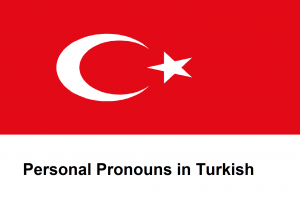Difference between revisions of "Language/Turkish/Grammar/Personal-Pronouns"
Jump to navigation
Jump to search
(Created page with "The words used in place of the name are called pronouns. There are 3 singular and 3 plural person pronouns. {| class="wikitable" !1.singular person !Ben !I |- !2.singular pers...") |
m (Quick edit) |
||
| (2 intermediate revisions by 2 users not shown) | |||
| Line 1: | Line 1: | ||
[[File:Personal Pronouns in Turkish.png|alt=Personal Pronouns in Turkish|thumb|Personal Pronouns in Turkish]] | |||
Hello everybody, | |||
In today's lesson you will learn '''"PERSONAL PRONOUNS"''' in Turkish. | |||
Feel free to edit this page by adding new words and expressions ! | |||
Happy learning! :) | |||
<span link>Don't miss the chance to check out these pages as you wrap up this lesson:</span> [[Language/Turkish/Grammar/RE%C4%B0TERAT%C4%B0VE|REİTERATİVE]], [[Language/Turkish/Grammar/Gender|Gender]], [[Language/Turkish/Grammar/How-to-use¨there-to-be¨-in-Turkish|How to use¨there to be¨ in Turkish]] & [[Language/Turkish/Grammar/The-Nominative-Case-in-Turkish|The Nominative Case in Turkish]]. | |||
{| class="wikitable" | |||
!'''<big>ENGLISH</big>''' | |||
!'''<big>PRONUNCIATION</big>''' | |||
'''<big>ENGLISH</big>''' | |||
!'''<big>TURKISH</big>''' | |||
!'''<big>PRONUNCIATION</big>''' | |||
'''<big>BRAZILIAN</big>''' | |||
'''<big>PORTUGUESE</big>''' | |||
!'''<big>BRAZILIAN PORTUGUESE</big>''' | |||
|- | |||
| | |||
| | |||
| | |||
| | |||
| | |||
|- | |||
|I | |||
|'''''behn''''' | |||
|'''<big>BEN</big>''' | |||
|'''''ben''''' | |||
|EU | |||
|- | |||
|YOU | |||
|'''''sehn''''' | |||
|'''<big>SEN</big>''' | |||
|'''''sen''''' | |||
|VOCÊ | |||
|- | |||
|HE | |||
|'''''oh''''' | |||
|'''<big>O</big>''' | |||
|'''''o''''' | |||
|ELE | |||
|- | |||
|SHE | |||
|'''''oh''''' | |||
|'''<big>O</big>''' | |||
|'''''o''''' | |||
|ELA | |||
|- | |||
|WE | |||
|'''''bihz''''' | |||
|<big>'''BİZ'''</big> | |||
|'''''biz''''' | |||
|NÓS | |||
|- | |||
|YOU (PLURAL) | |||
|'''''sihz''''' | |||
|<big>'''SİZ'''</big> | |||
|'''''siz''''' | |||
|VOCÊS | |||
|- | |||
|THEY | |||
|'''''ohn lahr''''' | |||
|'''<big>ONLAR</big>''' | |||
|'''''onlár''''' | |||
|ELES | |||
|} | |||
The words used in place of the name are called pronouns. There are 3 singular and 3 plural person pronouns. | The words used in place of the name are called pronouns. There are 3 singular and 3 plural person pronouns. | ||
{| class="wikitable" | {| class="wikitable" | ||
!1.singular person | !1.singular person | ||
| Line 26: | Line 102: | ||
|} | |} | ||
Postcripts: If <nowiki>''</nowiki>o<nowiki>''</nowiki> is used for the inanimate object, it is a demonstrative pronoun. | Postcripts: If <nowiki>''</nowiki>o<nowiki>''</nowiki> is used for the inanimate object, it is a demonstrative pronoun. | ||
==Other Lessons== | |||
* [[Language/Turkish/Grammar/The-Inclusive-Case-in-Turkish|The Inclusive Case in Turkish]] | |||
* [[Language/Turkish/Grammar/Conditional-Mood|Conditional Mood]] | |||
* [[Language/Turkish/Grammar/Prepositions|Prepositions]] | |||
* [[Language/Turkish/Grammar/Cardinal-Numbers-in-Turkish|Cardinal Numbers in Turkish]] | |||
* [[Language/Turkish/Grammar/REİTERATİVE|REİTERATİVE]] | |||
* [[Language/Turkish/Grammar/Questions|Questions]] | |||
* [[Language/Turkish/Grammar/The-Locative-Case-in-Turkish|The Locative Case in Turkish]] | |||
* [[Language/Turkish/Grammar/Pronouns|Pronouns]] | |||
* [[Language/Turkish/Grammar/The-Nominative-Case-in-Turkish|The Nominative Case in Turkish]] | |||
* [[Language/Turkish/Grammar/Be-Polite|Be Polite]] | |||
<span links></span> | |||
Latest revision as of 23:17, 26 March 2023
Hello everybody,
In today's lesson you will learn "PERSONAL PRONOUNS" in Turkish.
Feel free to edit this page by adding new words and expressions !
Happy learning! :)
Don't miss the chance to check out these pages as you wrap up this lesson: REİTERATİVE, Gender, How to use¨there to be¨ in Turkish & The Nominative Case in Turkish.
| ENGLISH | PRONUNCIATION
ENGLISH |
TURKISH | PRONUNCIATION
BRAZILIAN PORTUGUESE |
BRAZILIAN PORTUGUESE |
|---|---|---|---|---|
| I | behn | BEN | ben | EU |
| YOU | sehn | SEN | sen | VOCÊ |
| HE | oh | O | o | ELE |
| SHE | oh | O | o | ELA |
| WE | bihz | BİZ | biz | NÓS |
| YOU (PLURAL) | sihz | SİZ | siz | VOCÊS |
| THEY | ohn lahr | ONLAR | onlár | ELES |
The words used in place of the name are called pronouns. There are 3 singular and 3 plural person pronouns.
| 1.singular person | Ben | I |
|---|---|---|
| 2.singular person | Sen | You |
| 3.singular person | O | He,She,İt |
| 1.Plural person | Biz | We |
| 2.Plural person | Siz | You |
| 3.Plural person | Onlar | They |
Postcripts: If ''o'' is used for the inanimate object, it is a demonstrative pronoun.
Other Lessons[edit | edit source]
- The Inclusive Case in Turkish
- Conditional Mood
- Prepositions
- Cardinal Numbers in Turkish
- REİTERATİVE
- Questions
- The Locative Case in Turkish
- Pronouns
- The Nominative Case in Turkish
- Be Polite
